How to properly trim pomegranates in the garden and at home
Pomegranate is a low tree that looks aesthetically pleasing at all stages of development. It has a beautiful dense crown with small green leaves, delicate white flowers and bright, interestingly shaped fruits. In hot countries, pomegranate is grown in open ground, in most regions of Russia - as a houseplant.
An integral part of pomegranate tree care is pruning. The shape of the crown, the size of the fruit, and the health of the plant depend on the correctness and regularity of this procedure. We'll tell you in this article how to trim pomegranates in the garden and at home.
Why prune a pomegranate tree?
In the wild, pomegranate grows without pruning. Old and damaged branches break off naturally. Such trees have a dense crown, produce small and tart fruits, and have lower yields.
This is interesting! Wild pomegranates are hardier and less susceptible to diseases than cultivated varieties. Without timely pruning, cultivated trees begin to get sick and die.
Garden and indoor pomegranates need pruning.

This the procedure provides crops with many benefits:
- Aesthetic appearance of the crown. Without formation, the crown will look untidy. During pruning, the pomegranate crown is given a spherical, fan or bush shape. Bonsai - decorative home trees - are made from pomegranates.
- Early fruiting. Pruning excess shoots stimulates the formation of branches of a new order, on which fruits are formed - without formation, the side branches may not grow.
- Strengthening skeletal branches. When pruning excess shoots, skeletal branches receive space for development. They grow faster and are more powerful. This protects them from fractures under the weight of the fruit, due to exposure to wind and precipitation.
- Preventing crown thickening. The plant spends a lot of energy and nutrients on a too thick crown. Because of this, few inflorescences are formed, and the fruits are small. Extra branches create shading, which negatively affects the taste of the fruit. Also, the thickened crown creates optimal conditions for the development of fungi.
- Preventing infections and pests. Many fungi and insects overwinter under the cracked bark of the plant. Therefore, damaged branches must be removed.
Timing of the procedure
Pruning is carried out in spring or autumn. When pruning in spring, choose a period when the buds have not yet awakened. In autumn, the procedure is carried out after leaf fall.
Is it possible to prune pomegranates in summer? Experienced gardeners do not recommend doing this. Removing shoots during the active growing season in summer is stressful for the plant. Because of this, the tree stops blooming or drops fruit. Increased gum production may begin, increasing the risk of infection.
In winter, pomegranates cannot be trimmed.. This will reduce its frost resistance, and the plant will not survive the winter.
Interesting things on the site:
Types of pruning
Pruning is mandatory for pomegranate trees growing in the garden and at home. There are three types of procedure.
Sanitary
Sanitary pruning reduces the likelihood of plant damage by diseases and pests, reduces crown density. During this procedure, all damaged, broken shoots with cracked bark, dry and frostbitten branches, parts of the plant with spots, seals and other signs of infection and pests are removed.
Sanitary pruning recommended in autumn.

Formative
Formation makes the crown aesthetic, stimulates the formation of shoots, on which fruits and inflorescences are formed, reduces thickening. During the formation process, weak, improperly growing and excess shoots are removed, leaving the strongest and most developed ones. Some branches are cut to give the crown the desired shape.
Rejuvenating
Anti-aging pruning is used for old trees with reduced productivity.. Trim the entire crown, stimulating the growth of new shoots. The procedure is carried out no more than once every 25 years.
How to properly trim a pomegranate
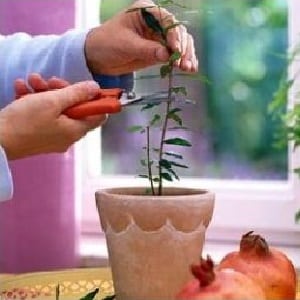 There are some differences between pruning indoor and garden pomegranates. On tree growing in a pot, not affected by weather conditions. Therefore, during sanitary pruning, fewer branches are removed. Formative pruning involves not only giving the crown an aesthetic and convenient shape, but also limiting the size of the plant.
There are some differences between pruning indoor and garden pomegranates. On tree growing in a pot, not affected by weather conditions. Therefore, during sanitary pruning, fewer branches are removed. Formative pruning involves not only giving the crown an aesthetic and convenient shape, but also limiting the size of the plant.
In the garden, much more attention is paid to sanitary pruning. The risk of disease and pests in open ground is higher. In addition, shoots often break under the influence of negative weather conditions. The size of the tree and its crown outside will be larger than in a pot - this is taken into account when forming.
Indoor
It is easier to form a fruit tree at home than in the garden.. In this case, the main task of the gardener is to give the plant a beautiful shape, remove damaged branches and bring the first flowering closer.
Since the tree is in constant temperature conditions, pruning is done before flowering and after fruiting. It is not recommended to carry out the procedure in winter, when even in warmth the life cycles of the plant slow down.
How to form an indoor pomegranate:
- Pinch the top when the plant reaches a height of 20-25 cm, stepping back 5 cm from the end of the seedling. This is necessary so that the tree begins to throw out side shoots.
- Pinch the side shoots when they reach a length of 15-20 cm to stimulate the formation of new branches.
- Leave no more than 3-4 branches of each order. Select the strongest and most developed shoots, remove old ones that are directed towards the center of the plant or downwards.
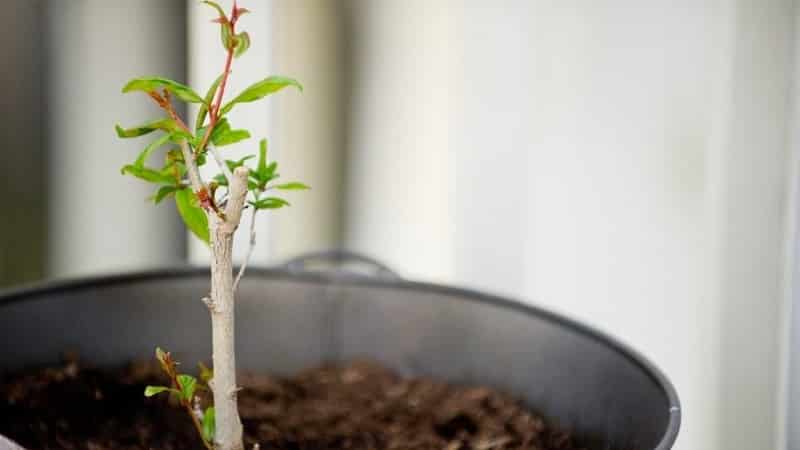
Every year the pomegranate is inspected for damage by diseases and pests., the presence of dry and damaged branches. Such parts of the plant are removed.
If desired, the crown can be trimmed to give it a shape.. The pomegranate tree successfully withstands pruning and retains its desired shape.
Note! The pomegranate tree will not reach a large size without pinching the growing point, since its growth is limited by the size of the pot. However, in this case, side shoots will appear later and will develop more slowly.
Garden
Proper pruning is important for garden pomegranate.. At home, there are no strict requirements for the size and quality of fruits, since tree is grown rather for decorative purposes. In the garden, the harvest is the gardener's priority goal. In addition, a properly formed tree can withstand wintering easier.
More stringent requirements are also placed on pruning times.. The procedure is carried out either in early May, while the buds have not yet woken up, but the temperature outside is already above zero, or in the fall, after leaf fall, before frost sets in. If pruning is carried out at low temperatures, this will lead to a decrease in frost resistance.
Pomegranate trimming looks like this::
- Remove all growth at the bottom of the pomegranate and near its roots. Do the same with branches that are tilted too close to the ground.
- Dried, thin and frozen shoots are completely cut off. The same applies to branches that have cracks in the bark.
- Leave up to 6 skeletal branches. It is important that they are located at the maximum distance from each other. The strongest and thickest branches are selected, weak shoots are removed.
- Remove branches directed into the crown.
Pinching the top is not necessary for garden pomegranates.. It is done if the tree is formed using the standard method. Then the top and formed branches are cut off when they reach a length of 20-30 cm.
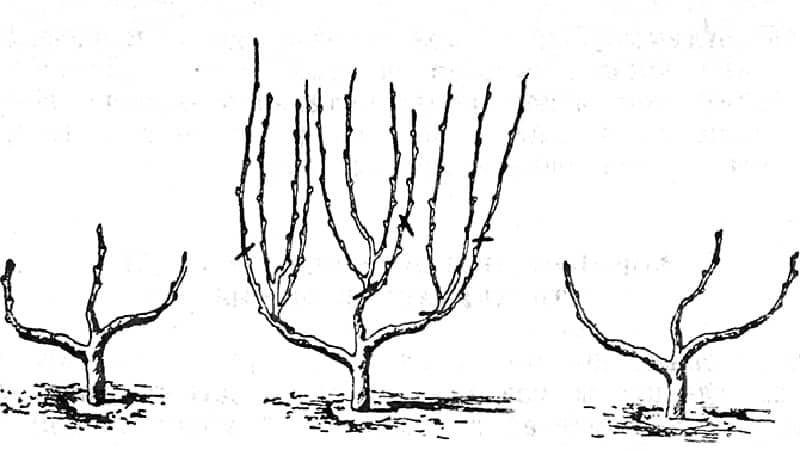
The nuances of pomegranate pruning
Pruning is stress for the plant, due to which immunity and stamina are temporarily reduced. If the procedure is carried out correctly, the tree quickly recovers and becomes even stronger.
In order not to harm the grenade, it is important to know a few nuances:
- Pruning is carried out in the morning or evening, when the sun is inactive. It is better to choose cloudy weather in the garden.
- On the day of formation, the plants are not watered. This will reduce the severity of stress and reduce the likelihood of plant infection.
- The tool used to trim branches and shoots is disinfected before use - calcined with fire, wiped with alcohol or a dark pink solution of potassium permanganate.
- The cut areas are treated with garden varnish to prevent the plant from becoming infected with infections and fungi, and also to prevent the release of large amounts of gum.
Methods for forming pomegranate
You can form a young pomegranate in different ways. Depending on the chosen method, the appearance of the crown and the entire plant will differ.
Fan-shaped
Forming a pomegranate in the form of a fan or bouquet requires proper garter of branches. Step-by-step instruction:
 Immediately after planting, remove branches located in the lower part of the plant (too close to the ground). Only the main trunk is left.
Immediately after planting, remove branches located in the lower part of the plant (too close to the ground). Only the main trunk is left.- When the side shoots are formed, choose two of them that are at the maximum distance from each other. The branches are fixed in the upward direction.
- 2 branches are also left in the next circle.
- The central trunk is shortened to the upper branch.
- Next, several branches of the second and third order are left and the given shape is maintained.
Custom
A pomegranate shaped like a bush is most convenient gardener This shape makes harvesting and sanitary pruning easier.
5-6 skeletal branches are left on the plant. Shoots located too close to the ground and excess shoots are removed. The crown of the plant is pinched at a height of 1.5-2.5 m.
In the form of a bonsai
Bonsai - a real work of art. To get a beautiful Japanese-style pomegranate, it begins to be shaped already in the first year of life.
Basic rules for its creation:
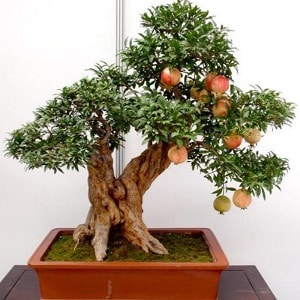 The tree is pinched when its height reaches 20-25 cm.
The tree is pinched when its height reaches 20-25 cm.- The trunk, whose diameter does not exceed 2.5 cm, is given a curved shape. To do this, a wire is wound from its base to the crown so that it does not pinch the trunk and does not interfere with sap flow.Using wire, the trunk is given the desired shape.
- The most developed branches are selected. Leave those shoots whose location corresponds to the intended shape of the crown.
- Skeletal branches are also given the desired shape using wire.
- The branches are cut and trimmed to achieve the desired crown.
It is important to remove the wire in a timely mannerso that it does not leave deep scars on the branches and bark. This is done when the fixed trunk is compacted and takes on the desired shape.
Note! To correctly form a bonsai, it is recommended to draw its diagram in advance.
Standard
Standard formation is used most often. Rules for this method:
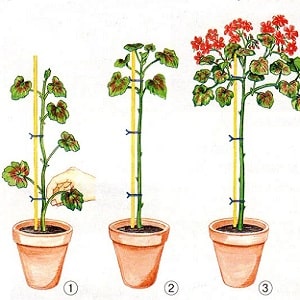 Select the central branch of the seedling. All other shoots are removed.
Select the central branch of the seedling. All other shoots are removed.- A wooden support is installed near the trunk. The trunk is tied to it so that it turns out perfectly straight.
- Leave 2-3 skeletal branches, located as far as possible from each other, on the first circle. They are shortened to the desired length. They do the same with the branches of the second circle, but they are made even shorter.
- The top of the pomegranate is cut off. Next, the shape of the tree is maintained.
How to weave a pomegranate
The intertwined trunk of an indoor pomegranate tree looks especially aesthetically pleasing.. It is not difficult to form a pomegranate in this way.
How to weave a pomegranate tree trunk:
- Two shoots are selected from the seedling, located as close to each other as possible. They are intertwined with each other, cutting the bark and fixing the branches with electrical tape at the points of contact. The trunk is tied to a support.
- All branches that are below 15 cm from the ground are removed.
- Next, three levels of skeletal branches are formed.
- The top of the tree is pinched when the main trunk reaches 15 cm.
Subsequent pruning involves the sanitary removal of damaged and dry branches, as well as maintaining the shape of the crown.
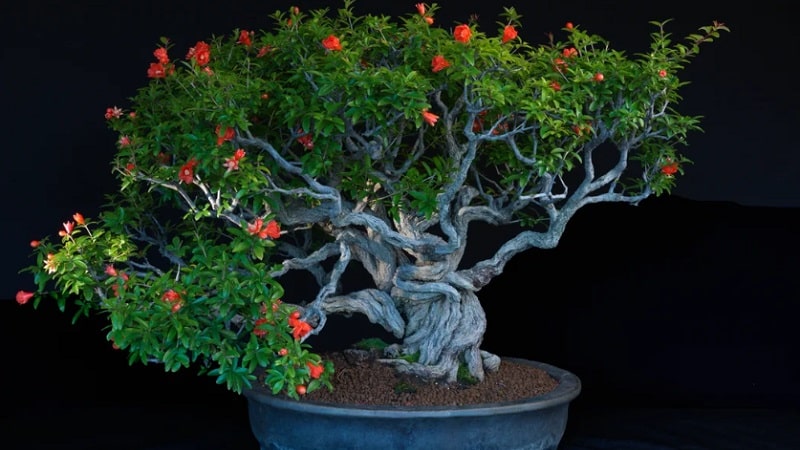
Is pinching necessary?
Many novice gardeners wonder whether they need to pinch pomegranates. It depends on how the plant is formed.
Most gardeners are of the opinion that it is necessary to limit the growing point. This procedure stimulates the growth of side shoots and helps make the tree as convenient as possible for harvesting and care.
Care after the pruning procedure
In order for the plant to recover faster after pruning, it is important to properly care for it. Basic care corresponds to the standard scheme, but there are some differences:
- Experienced gardeners recommend treating the tree with fungicides and insecticides or copper-containing preparations after formation. This will reduce the likelihood of infection of a plant weakened after the procedure.
- After pruning, all fallen leaves, branches and other plant debris are collected and burned. The soil is watered with an antifungal agent.
- On the first day after pruning, pomegranates are not watered or fed.
Conclusion
Pruning of pomegranate is necessary for the tree to develop correctly. The procedure helps to give the plant a comfortable and aesthetic shape, speed up fruiting, improve the quality and quantity of the harvest, and prevent infection and pests.
There are several types of pruning. If you follow the step-by-step instructions, even a beginner can handle each option.